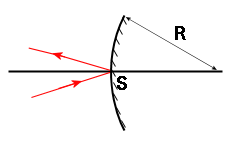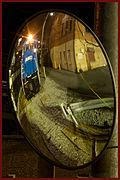Uses of Convex Mirror and its Applications
What is convex mirror? What are the uses of convex mirror class 10 mirror in daily life?
A convex mirror is a spherical reflecting surface with a bulging side that faces the source of light. Convex mirrors, often known as fish-eye mirrors by car enthusiasts and diverging mirrors by physicists, have a wide range of applications of convex mirrors. The phrase "diverging mirror" comes from the fact that when rays are reflected, they diverge. When a parallel light beam strikes a convex mirror, it reflects outwards and travels away from an imaginary focus point directly.
JEE Main/NEET 2027: Physics Important Formulas for Class 10
NEET 2025: Mock Test Series | Syllabus | High Scoring Topics | PYQs
JEE Main: Study Materials | High Scoring Topics | Preparation Guide
JEE Main: Syllabus | Sample Papers | Mock Tests | PYQs


The following are some examples of uses of convex mirror class 10 mirror applications-
- Building interiors
- Mirrors on vehicles
- magnification glass
- For the sake of security
The convex mirror always creates a virtual image of the object, and the image created by the convex mirror is always smaller than the actual object. As a result, the most prevalent applications for convex mirrors are in situations where larger things must be observed on a smaller scale. Convex mirrors are more commonly utilized inside car mirrors than concave or plane mirrors because they have a larger visual field. The following are some of the most important and common applications of uses of convex mirror.
Also read -
- NCERT Solutions for Class 11 Physics
- NCERT Solutions for Class 12 Physics
- NCERT Solutions for All Subjects
Write the uses of convex mirror class 10 or Write two uses of convex mirror class 10 mirror.
The passenger-side mirror on your car is one of the most prevalent uses for the uses of a convex mirror. Convex mirrors are utilized in automobiles because they produce an upright picture and a broader field of view due to their curved outwards design. Hospitals, hotels, schools, stores, and apartment buildings all have convex mirrors in their hallways.
Typically, these mirrors are fixed to a wall or ceiling at intersections or abrupt turns in passageways. This removes blind zones and allows people to see their surroundings clearly. The convex mirror always creates a virtual image of the object, and the image created by the use of a convex mirror is always smaller than the actual object. As a result, the most prevalent applications for convex mirrors are in situations where larger things must be observed on a smaller scale. Convex mirrors are more commonly utilized inside car mirrors than concave or plane mirrors because they have a larger visual field. The following are some of the most important and common applications of uses of the convex mirrors.
Another application of the convex mirrors is to examine your product from various angles during the manufacturing process, such as on the conveyor belt. This can improve the quality of your products by alerting you to any manufacturing flaws, as well as boost the efficiency of the manufacturing process by eliminating the need to inspect your products by picking them up from the conveyor belt.
Related Topics Link, |
Convex mirrors used inside the buildings-
A convex mirror is used in large workplaces, stores, and hospitals to allow people to look around the corner and avoid colliding with one another.
Convex mirrors used in vehicles-
Because they can diverge light beams and create virtual pictures, convex mirrors are commonly employed as rear-view mirrors in automobiles and transportation.

Convex mirrors used for security purposes-
Convex mirrors are often employed for security in a variety of settings. They are locations near ATMs where bank customers can check to see if someone is standing behind them.
These were some of the most prevalent applications for convex mirrors in the real world. Convex mirrors are also utilized in a variety of other applications, such as street light reflectors because they can distribute light over a larger area. They're also used to build mirrors for telescopes and ceiling domes.
Also Read:
- NCERT solutions for Class 12 Physics Chapter 9 Ray Optics and Optical Instruments
- NCERT Exemplar Class 12 Physics Solutions Chapter 9 Ray Optics and Optical Instruments
- NCERT notes Class 12 Physics Chapter 9 Ray Optics and Optical Instruments
Convex mirrors used in street lights-
Because it can disperse light beams across a broader area, convex mirrors are utilised as street light reflectors.
Convex mirrors used in sunglasses-
The development of a sunglass lens uses convex mirrors. The overall goal of these glasses is to reflect sunlight away from the wearer.
Convex mirrors used in telescope-
In telescopes, convex mirrors are employed to provide point-sized views of faraway objects.
Also check-
- NCERT Exemplar Class 11th Physics Solutions
- NCERT Exemplar Class 12th Physics Solutions
- NCERT Exemplar Solutions for All Subjects
NCERT Physics Notes:
Frequently Asked Questions (FAQs)
The following are three applications for convex mirrors:
It also serves as a vigilance mirror
It's utilized in street lamps as a reflector.
It used as a rearview mirror in vehicles
Convex mirrors are employed in the construction of structures, as well as in the manufacture of eyewear lenses, magnifying glasses, security systems, and telescopes.
Microscopes, magnifying glasses, and eyeglasses all use convex lenses. They're also employed in cameras to provide realistic views of objects that are far away.
The person withdrawing cash can keep an eye on what is happening on behind them by strategically installing convex mirrors in an appropriate location, allowing them to respond quickly if someone suspect appears.
The drivers' eye-to-mirror distance has an impact on distance/depth perception in mirrors. Due to higher eye-to-mirror lengths than driver-side mirrors, convex passenger-side mirrors generate a greater overestimation of a following vehicle's distance (Flannagan et al., 1997).
Also Read
02 Jul'25 07:56 PM
02 Jul'25 06:11 PM
02 Jul'25 05:17 PM
02 Jul'25 05:09 PM
02 Jul'25 05:08 PM
02 Jul'25 05:08 PM
02 Jul'25 05:07 PM
02 Jul'25 05:07 PM
02 Jul'25 05:04 PM
02 Jul'25 05:01 PM

